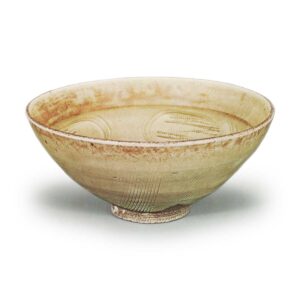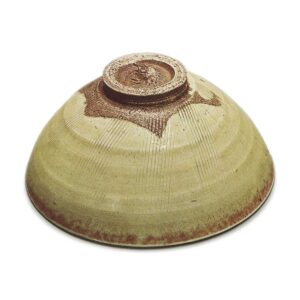

Idemitsu Museum of Arts
Height: 6.8-7.0cm
Diameter: 15.0-15.2cm
Base diameter: 5.0cm
Height: 0.9cm
Shuko celadon is a type of celadon that is rare, and the only example recorded in the Taisho Meiki Kan (A Guide to Famous Tea Utensils of the Taisho Period) is the one in the collection of Mr. Masayoshi Kato. The name “Shuko Seiji” is said to have come from the fact that the tea master Murata Shuko loved this type of tea bowl, thinking that this type of unglazed celadon, which was clumsy and austere, was more suitable for tea than the skillfully made, beautiful Kinuta celadon. During the Momoyama period, they were called Shuko tea bowls, but it is not clear when they started being called Shuko celadon. It was probably during the Edo period, but when exactly?
Shuko celadon is said to have been made in Tong’an, Fujian Province, during the Southern Song dynasty. The fact that Shuko celadon is from the Southern Song dynasty is also clear from the fact that it has been discovered in quite a few Kamakura-era ruins. I don’t know of any examples of tea bowls that have been discovered, but small plates of the same type of celadon have been excavated from both Saga and Fukuoka prefectures. In addition, fragments of the small plates have been found in considerable numbers at various Kamakura-era archaeological sites in Fukuoka Prefecture, as well as at the Kusado Sengen archaeological site on the Ashida River in Fukuyama City, Hiroshima Prefecture, and they have also been collected in considerable numbers from the Kamakura coast.
For a long time, it was a question of where the Shuko celadon was made. Before the war, Mr. Yoneuchi Yōnosuke collected Shuko celadon fragments in the early Showa period in Deqing County, Zhejiang Province, so I imagined that it might have been made at the Deqing kilns, but this was a mistake. In June 1952, the Fujian Provincial Cultural Relics Management Committee investigated the same kiln, and in 1956, Chen Wanli and others from the National Palace Museum conducted a survey and published their findings in the “Cultural Relics Reference Materials” (1957, No. 9) under the title “A Brief Note on the Investigation of Ancient Kiln Sites in Fujian”.
This was the first time we learned that the jade-green celadon was made in Tong’an, Fujian Province. Similar items were also made in the Wan’an kiln area of Quanzhou, and some of these items were brought to Japan. It is a matter for the future to determine which of these two places produced the jade-green celadon.
Shuko celadon is a type of celadon ware in which the body is grayish white, but a relatively thick transparent glaze is applied to it, and it is often oxidized to a loquat-colored hue. Perhaps Shuko chose this tea bowl over Kinsei celadon because it is oxidized to a warm, soft loquat color. For example, there are rare examples of Shuko celadon tea bowls, such as the “Shikai Kyodai” (Four Seas Brothers) bowl at Ginkakuji Temple in Kyoto, but Shuko celadon is characterized by its bluish, oxidized, loquat-colored glaze, similar to Ningyo-te celadon.
Another characteristic of Shuko celadon is the pattern of scratches and indentations made by pressing or scratching with a comb, which is commonly referred to as “neko-kaki” (cat scratches). This pattern is not seen in Longquan-style Zhejiang celadon, and appears to have been popular only in the Fujian province, around Quanzhou.
This jukō celadon tea bowl was handed down at Honganji Temple in Kyoto, and the body is a hard, grayish-white porcelain. It is covered with a transparent, light loquat-colored glaze, and the body is exposed below the waist.
It is a flat tea bowl with a wide mouth, a plump body, and a small, tight foot ring. The exterior has a pattern of scratches made with a comb, known as “neko-kaki” (cat scratches), and on the inside, there are cloud-shaped carvings in free, flowing lines on three sides, with a pattern of comb-like carvings pressed into the cloud shapes.
There is a slight nick on the rim and foot, but it is almost perfect, and as a jukō-seiji it is a superb tea bowl with a beautiful shape, a well-arranged pattern, and excellent firing.



